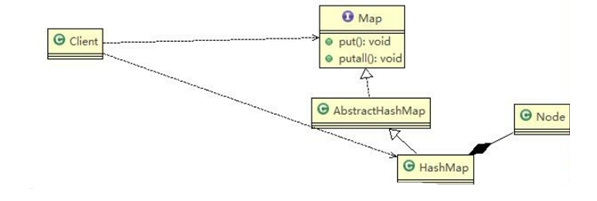- Java的集合类-HashMap就使用了组合模式

# 编写测试代码
public class HashMapComp {
public static void main(String[] args) {
Map<Integer,String> hashMap=new HashMap<Integer,String>();
hashMap.put(0, "东游记");
Map<Integer,String> map=new HashMap<Integer,String>();
map.put(1, "西游记");
map.put(2, "红楼梦");
hashMap.putAll(map);
System.out.println(hashMap);
}
}
# 查看Map
public interface Map<K,V> {
}
# 查看实现
public class HashMap<K,V> extends AbstractMap<K,V> implements Map<K,V>, Cloneable, Serializable {
}
# 静态内部类,叶子节点
static class Node<K,V> implements Map.Entry<K,V> {
final int hash;
final K key;
V value;
Node<K,V> next;
}
1) 简化客户端操作。客户端只需要面对一致的对象而不用考虑整体部分或者节点叶子的问题。
2) 具有较强的扩展性。当我们要更改组合对象时,我们只需要调整内部的层次关系,客户端不用做出任何改动.
3) 方便创建出复杂的层次结构。客户端不用理会组合里面的组成细节,容易添加节点或者叶子从而创建出复杂的树形结构
4) 需要遍历组织机构,或者处理的对象具有树形结构时, 非常适合使用组合模式.
5) 要求较高的抽象性,如果节点和叶子有很多差异性的话,比如很多方法和属性都不一样,不适合使用组合模式



【推荐】国内首个AI IDE,深度理解中文开发场景,立即下载体验Trae
【推荐】编程新体验,更懂你的AI,立即体验豆包MarsCode编程助手
【推荐】抖音旗下AI助手豆包,你的智能百科全书,全免费不限次数
【推荐】轻量又高性能的 SSH 工具 IShell:AI 加持,快人一步
· 阿里巴巴 QwQ-32B真的超越了 DeepSeek R-1吗?
· 10年+ .NET Coder 心语 ── 封装的思维:从隐藏、稳定开始理解其本质意义
· 【设计模式】告别冗长if-else语句:使用策略模式优化代码结构
· 字符编码:从基础到乱码解决
· 提示词工程——AI应用必不可少的技术
2021-08-31 vue开发:前端项目模板